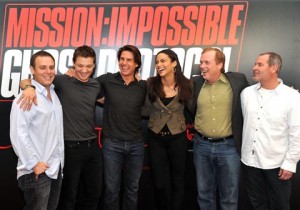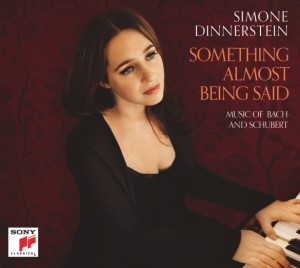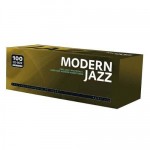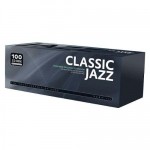At the Woodstock Library desk, a woman I didn’t know recently asked me, “Are you Leslie Gerber?” I asked how she knew. “I recognized your voice,” she said. “I used to listen to WDST.”
She had a long memory, but I’ve had this experience occasionally over the years, since I left WDST in 1991 after eleven years on the air. I actually launched the station; my weekday program, “The Concert Hall,” was the first of the station’s regular broadcasts, at noon on April 30, 1980. I still have a recording of that show, which I can use to embarrass myself whenever I need taking down. But I did get a lot better.
WDST started out as an idea of Jerry and Sasha Gillman’s. After they moved to Woodstock in the 1970s, they soon realized that there was no radio station in Woodstock, nor any nearby that reflected the cultural life of the town. Since Woodstock was already “the most famous small town in the world,” due to the festival that had not occurred here, they thought a Woodstock station might do well in the surrounding area. Eight years after their first application for a license, WDST finally went on the air. The station’s nickname was “the bulldog of the Hudson Valley.” It was chosen partly because of the tenacity required to get the station started. Also, the Gillmans had bulldogs as pets.

Jerry thought that a successful radio station didn’t have to be homogeneous. He was planning to run a commercial station and to make money with it–which he did–but he also wanted to have fun and to do things he thought were worthwhile. After deciding what kinds of music he wanted on his station, instead of looking for radio people who could handle those types of music he looked for people who knew the music. He told me he thought it would be easier to teach radio skills to people who knew music than to teach music to people with radio skills.
As it happened, one of his first hires, Jeanne Atwood, had gone to broadcast school. But most of the rest of us had little if any radio experience. I had done college radio for only a few months, and I had made many guest appearances on classical music stations, but I hadn’t run my own program for twenty years. It didn’t matter. I learned quickly. So did everyone the Gillmans hired with the sole exception of John Herald. John was a wonderful bluegrass musician and songwriter and an excellent programmer, but after months on the air he was still uncomfortable with “the board” and he gave up.
At the reunions we’ve had on the 25th and 30th anniversaries of the station’s beginnings, most of us who were on the air in the early days have assembled to share our happy memories of the place. We were a fun crowd in the early days, and we had a real sense of accomplishment. Jerry, who was very interested in news and politics, had a real news staff providing a lot of local reporting and occasional features. He interviewed many of the area’s politicians, often repeatedly. My own classical music programs reached a lot of people who caught them because they were listening for something else on the station. The promoters of one local concert series told me they could never have survived without my listeners. Betty MacDonald, herself a fine jazz singer and violinist, worked tirelessly to promote jazz performances in the area, and hosted many interviews with jazz musicians. She told me that one of the highlights of her life was interviewing Sonny Rollins. (One of mine was interviewing Aaron Copland for one of my programs.)
In the earliest days the station tried out a number of specialty programs which quickly fell out of favor. I remember a Sunday opera program, hosted by a strange woman whose name I can’t remember. One week she came in with what she said was her favorite recording of a Mozart opera, and apologized because the LPs had been “well loved.” At the beginning of the show I wondered how she was going to fit that work, which ran for three hours, into her two hour time slot, but I needn’t have worried. The records skipped so often that she finished well within her time. On her final week, she opened her program by saying she didn’t feel like listening to opera that day and she played instead some avant-garde music so weird that even I couldn’t stand it.
One rather feckless woman named Cindy did a one-hour Sunday program of Broadway show music. I happened to be engineering for her the week she interviewed the participants in an upcoming performance at the Woodstock Playhouse. One of them was a surly teenager who answered all her questions with “Yeah” or “Nah.” Instead of sticking with the other cast members, Cindy kept asking her questions.
As the station evolved, more and more of what I called the “mutant” programming fell out. But as long as the Gillmans owned the station, it remained a “mixed format” station, and a very successful one. It started making money fairly early in its run. I remember that in 1987 we saw an Arbitron survey of local radio which showed that WDST was the #1 Ulster County radio station on weekends, which was when we still had the most “mutant” programming, including lots of classical music.
After the Gillmans sold the station to a lawyer, the advertising staff began making the decisions, and the quotient of pop music started rising. I left when I was told that my Sunday afternoon classical program was being canceled. The owner asked me to stay on for Saturday and Sunday mornings. I told him that all my best programs, with interviews and even live performances, had been possible only on Sunday afternoons and that if I couldn’t do them there was no point in staying on. “But,” he protested, “right now you’re getting the highest pay of anyone on the air.” I was making $7.50 an hour.
Today, WDST is a pop music station. The only “mutant” programs left are the “Woodstock Roundtable” hosted by Doug Grunther (the only one of the original programmers still on the air, I believe) early Sunday mornings, and “Blues Break” with Big Joe Fitz on Sunday nights. I hardly ever listen to it anymore. Remembering the old days is much more fun.
Walmart and Amazon are both out to conquer the U.S. retail world. Walmart is already the largest business in America, while Amazon is often cited as the growing monster. I avoid shopping at Walmart, but I frequently buy from Amazon. And, more significantly for me, I make a good part of my living selling through Amazon. That’s an opportunity Walmart doesn’t offer.
If you haven’t seen the documentary “Wal-Mart: The High Cost of Low Price,” perhaps you’ve caught one of the ads Walmart was blasting on TV during the recent Christmas shopping season. It ended with a woman sniffling as she said goodbye to all other stores. I found that a revealing clue about Walmart’s corporate attitude. In place after place across the U.S., Walmart has established its stores and then done its best to drive other retailers, from competing chains to mom and pop stores, out of business.
The “High Cost of Low Prices” documentary (not on sale at Walmart.com!) demonstrated the way the chain pursues greater sales through low price advertising, even to the extent of pressuring manufacturers to shift their production from the U.S. to China so that Walmart can sell their products for less. It has also encouraged reputable companies to produce lower quality goods to reduce their prices. Those that have refused have found that Walmart won’t offer their merchandise. Walmart is also often dishonest about claiming its prices are the lowest on everything it offers. They aren’t.
Shopping at Walmart has been far from a convenient experience the few times I’ve tried it. The stores are deliberately vast. Unless you’re familiar with the layout, finding almost anything can be a chore. And there are often long waiting lines at cash registers. It has been well documented that one way Walmart seeks to keep prices down is the way it treats its labor. Walmart is the largest private employer in the U.S.. Its workers are poorly paid and otherwise mistreated, and managers are pressured to keep paid employee hours to a minimum.
Target, another chain which has demonstrated corporate citizen problems, has a sign in every store announcing the amount the store donates to local charities. I haven’t seen signs like those in Walmart.
By comparison, Amazon seems like a good corporate citizen Recently, when Michael Moore had a new book, “Here Comes Trouble,” published in time for the Christmas season, he asked people on his mailing list to buy copies from their local independent booksellers (the option I chose) or from independent booksellers in his home state of Michigan. He also pointed out that for those to whom the cost of books was a problem, the book was available at a huge discount through Amazon. He didn’t mention Walmart. (To be fair, Walmart does sell the book on-line at a sizeable discount. Amazon’s price is lower, though.)
I’m sure an exhaustive investigation of Amazon’s business practices would turn up some things I wouldn’t like. But it’s no Walmart.
Instead of seeking a Walmart-like monopoly on sales, Amazon offers its huge customer base to anyone willing to pay it a small commission on sales. Not only do I buy a lot of things through these “Associated Sellers,” I’m one of them. Since I had to close my own mail-order business (not due to competition from Amazon), I have been selling used CDs through Amazon. My competition there is from other independent sellers, which is fair enough. Amazon relays orders to me, takes a very reasonable 15% commission, and pays me promptly every ten days (more often if I request).
One used book dealer I know, after years of selling through his own website and a large specialist on-line book site (ABE), took the plunge into Amazon sales a couple of years ago. He told me the experience was like moving from a rural road to Times Square.
Buying from Amazon could hardly be easier. Its searches do have a tendency to overload the results with oddly irrelevant material, but I still nearly always find what I am looking for. I even discovered through Amazon a very reasonable supplier of vitamin and mineral supplements (Swanson), which has its own obviously large operation but also sells through Amazon.
My daughter Jaida, a published writer, likes to buy from the great independent bookseller Powell’s in Portland, Oregon. Powell’s is indeed a wonderful place. Unlike Jaida, I’ve actually been to the store, which occupies an entire city block and is so large it devotes one story to a parking lot. Powell’s website has a lot of interesting reading on it, including independently written reviews and contributions from an uncommonly intelligent array of customers. But Powell’s serves only itself. Amazon enables me to sell.
Years ago I wrote many reviews of classical CDs for Amazon. That work dried up as Amazon began to solicit unpaid review of everything it sells from customers. These reviews have no quality control aside from other customers’ ratings of them , but I’ve still found some of them very useful sources of information. For example, the Mill Creek company offers large compilations of public domain video material (sometimes 50 or 100 movies in a box) at extremely low prices, but Amazon’s offerings of them don’t include contents listings. You can be certain that some customer will have listed all of the contents in a review.
A couple of years ago, in a moment of weakness, I joined Amazon Prime. That service, among other things, gives me free two-day shipping on all purchases. It costs me $70 a year, but I’ve found it still saves me money and I’ve renewed it. Now Amazon Prime subscribers are being offered free access to thousands of streaming movies and TV shows on line. I can’t wait to get my new Blu-ray player on line!
Movie lovers like me often make the director of a film our main point of interest. I don’t allow myself such nonsense as having a “favorite” director. But I can tell you that I have seen every feature film Robert Altman ever directed. (even the TV movie “Nightmare in Chicago,” which has never been issued on commercial video), most of them more than once. The main reason I prefer Buster Keaton’s movies to Charlie Chaplin’s is that I find Keaton the superior director. Both of them were superb screen comics but the direction elements in Keaton’s films
are among the most inventive and satisfying of the entire silent film era.
Since Altman’s death, I’ve been paying attention to the directors of films I love, hoping for someone whose work I would enjoy as much as his. When I saw Michael Gondry’s “Eternal Sunshine of the Spotless Mind,” I thought I had found a new top genius. (Hearing him speak in New York once reinforced that impression. And I was already a great fan of his music videos.) But although I also loved Gondry’s “The Science of Sleep
,” I was deeply disappointed by “Be Kind, Rewind,” which he wrote. It was a marvelous conception carried out carelessly and without focus. And as much as I enjoyed “The Green Hornet
” (the departures from comic book orthodoxy not bothering me at all because I’ve never cared much about comic books), even Gondry’s imaginative work didn’t make it a great film. I was finally forced to recognize that Charlie Kaufman’s brilliant script had as much to do with the success of “Eternal Sunshine” as the direction.
Kaufman’s directing debut, “Synecdoche, New York,” struck me as a masterpiece. But he hasn’t had a chance to direct since, and if he goes on writing unconventional scripts like that one he may never.
One of my favorite films of recent years was the Pixar animated masterpiece “Ratatouille.” I have watched that one repeatedly with ever-increasing admiration for it, and for its director Brad Bird. Bird had also directed Pixar’s excellent “The Incredibles.
” Was he going to become a favorite director? Curiosity has just driven me to see Bird’s live action debut, the latest installment in the “Mission Impossible” franchise. I should admit that, although I do enjoy a good action movie sometimes, I would probably never have gone to see the fourth movie in this series if I hadn’t been curious about Bird’s work. And reviews were pretty good.
It’s a disaster. The “plot” is ridiculous and incoherent. The story makes no sense at all. There’s no apparent continuity between one scene and another except that good guys are chasing bad guys and trying to keep the world from being destroyed. Characters’ motivations are barely even referred to, and then so cursorily that you can’t really understand what bugs are up their respective asses. Perhaps if I’d been paying better attention by the end of the movie, I might have understood why Ethan, Tom Cruise’s character, finally reunited with his beloved wife, waves to her at a distance as she smiles at him and enters a building with someone else. But by then I didn’t care.
Did Bird’s contribution to this stupid mess make any difference? I don’t know. The various explosions and stunts were all pretty noisy and gaudy, but since there was no emotional involvement with the characters or the situation they didn’t mean anything to me. When Cruise was trying to climb up the side of the top stories of the tallest building in the world and one of his magic adhesion gloves failed, I hoped he would fall and put an end to the picture. And as the renegade atomic missile streaked through the stratosphere and the magic timer counted towards zero, I was hoping it would blow up and put us all out of our misery.
OK, any great artist is entitled to a flop here and there. Beethoven, after all, not only wrote “Wellington’s Victory,” he proclaimed it one of his best works. (I’m not alone in considering it one of the worst pieces of crap ever written by a great composer.) But “Mission Impossible: Ghost Protocol” left me strongly suspecting that “Ratatouille” was the product of a great creative team, among whom the director was merely a successful technician rather than a major motivator.
This experience actually does not help me answer the question posed by my title. Frankly, I can’t answer it. Of course, a great artist like Akira Kurosawa managed to infuse many films with his personal vision as well as his technical skills, and the films are his films. But if you think “Casablanca” is a great film, tell me who directed it. (I remember this one: Michael Curtiz.) And if you can do that, answer my favorite movie trivia question. In 1939, the year of “Gone With the Wind,” its director made one other film. Name it. I’m not even asking for the name of the director, since most people who do manage to answer the question will not know the director’s name. The film was “The Wizard of Oz,” and the director was Victor Fleming. Go figure.
Right now I’m keeping a hopeful eye on Sylvain Chomet, the French-Canadian animator now working in Scotland. His first film, “The Triplets of Belleville,” was one of the most satisfying movies of recent decades, one I’ve watched repeatedly and shared with numerous friends. His follow-up, “<The Illusionist
,” a tribute to Jacques Tati based on an unpublished script of his, was even better, a significant evidence of artistic growth and a more deeply emotional and involving experience. I can’t wait for his next movie—but I’ll have to. After the success of “The Triplets,” it took Chomet eight years to make “The Illusionist.”
When I first heard the pianist Simone Dinnerstein, I was very favorably impressed with her playing. Perhaps that helps to explain why I have been so disappointed in her recent development.
Dinnerstein’s performances with cellist Zuill Bailey at Maverick Concerts were splendid. One time they played all of Beethoven’s Cello Sonatas in one concert. (They also recorded them for Telarc.) And at the Bard Music Festival devoted to Aaron Copland, she played Copland’s “Piano Variations” with such intensity that I was literally in tears at the conclusion. I can understand why Copland told a friend that the “Piano Variations” was his favorite among his works. Dinnerstein played it better than anyone else I’ve heard–and I’ve heard it many times–except for the composer’s own recording.
I’d actually been hearing about Dinnerstein for several years before I actually heard her play. Her father, a well-known painter, is a friend of one of my best friends, and I’d been hearing from him about Simone’s prodigious talent. Hearing her in person confirmed the reports.
So I was excited, five years ago, by the chance to hear Dinnerstein play Bach’s “Goldberg Variations” nearby, at Bard College, and I went with high expectations. I was appalled by what I heard. She seemed to have no idea of proper Bach style, frequently deviating from regular meter to make exaggerated expressive points. I don’t say that Bach playing has to be rigidly metronomical to be “correct.” But Bach is a baroque composer, not a romantic, and the power of constant rhythm is an essential aspect of his music. Dinnerstein played as if she were totally unaware of this aspect.
The performance was quickly followed by a recording, issued by Telarc. I heard it, and it was similar to the live performance I had attended. While some reviews shared my outlook, others hailed the disc as a “fresh” outlook on Bach’s music. The disc became such a best-seller (within the context of classical music sales, of course) that Dinnerstein was quickly snapped up by Sony Classical.
Dinnerstein’s third CD for Sony, entitled “Something Almost Being Said”, will be released on January 31, 2012. It represents a bit of a departure, since it’s not all Bach; it includes two Bach Partitas and also the first set of Schubert Impromptus, D. 899. Listening through it, one can tell that Dinnerstein is a well-equipped pianist. She has the dexterity and control to play demanding music in any way she wishes. And, at first, the CD, which begins with Bach’s Second Partita, sounds as though it might be a good one. Although there is some fooling about with rhythm in the opening Sinfonia, it’s still mostly well disciplined. But as the work progresses, Dinnerstein deviates more and more from strict tempo, reminding me of my reaction to a Bach performance I heard a couple of years ago. After a violinist’s rhythmically free playing of a fugue for unaccompanied violin, I wrote in a review, “Disrupting the rhythm of a Bach fugue to make a point is like interrupting sex to answer a telephone call.” It’s that disturbing. The final “Capriccio,” one of the most difficult movements in Bach’s keyboard works, is so fast it sounds hectic.
The Schubert Impromptus are no better. Dinnerstein’s tempo for the first, in C Minor, is so slow that the piece takes her 11:37 to play. By contrast, the great Artur Schnabel plays it in 8:53. For a piece of that length, 2 ½ minutes is a tremendous difference in time. And if you hear the way Dinnerstein starts to toy with the rhythm of the music at 4:25 of this movement, you may wind up as unhappy as I am.
But the worst example I can cite is Dinnerstein’s playing of the opening movement of the First Partita, played at a ludicrously slow tempo and with rhythmic freedom that would be excessive in Chopin. This is truly awful musicianship.
Dinnerstein is, alas, only the latest in a series of prominent musicians who have come to fame by playing in a manner I consider self-indulgent and unmusical. Such pianists as Ivo Pogorelich, Mikhail Pletnev, and Olli Mustonen have become great successes with performances that I doubt would have won them admission to any major music conservatory. Recently I heard a Chopin Prelude on the radio and said to my wife, “I don’t like this pianist.” It was Pogorelich. Mustonen, whose recordings had driven me crazy with their excessive rhythmic freedom, found a new way to antagonize me by recording a complete CD of Beethoven Variations and playing them with weird detachment and hyper-clear articulation.
One day I was listening to the radio and heard some unaccompanied violin music I did not recognize. It took me two minutes to realize it was the unaccompanied portion of Ravel’s “Tzigane,” music I know very well, but being played so freely it was unrecognizable. “Ah,” I said to myself, “must be Nadia Salerno-Sonnenberg.” It was. But some people like this kind of playing. Remind me not to invite them over for dinner.
Wondering what to do with your Christmas bonus or cash gifts? I know how you can get a 500-disc series of jazz recordings for about $500.
This series, entitled “The Encylopedia of Jazz,” is probably the largest-scale recording project ever put together. Experts and collector friends I consulted couldn’t come up with anything in the past larger than the Philips “Great Pianists of the 20th Century,” 100 two-disc sets.
“The Encylopedia of Jazz” is published by Membran, a huge German conglomerate which has issued many super-bargain sets in the past. I own quite a few of its “Quadromania” boxes, four disc sets which I bought for an average of about $12. They include fine selections, mostly of jazz musicians but sometimes classical music, in quite good sound, with good documentation and even rudimentary program notes. Membran also has issued many 10-disc sets, economically packaged in small boxes with the individual discs in strong paper sleeves. These sets come with no documentation at all, just names of performers and titles. I have a wonderful Ella Fitzgerald set in this series, and a box of tango recordings most of which come from 78s. They’re delightful. I had the Miles Davis set also, but I gave it away because I was so frustrated in being unable to find out who was playing on each individual track. (Also, apparently to get around copyright laws dealing with compilations, Davis’s LPs were broken up between different CDs, making for a frustrating listening experience.)
“The Encylopedia of Jazz” was issued in 2008. This leaves me fearful that it could disappear before too long. Membran once had a 168-disc set of ragtime and early jazz, which I frequently saw on eBay. I was determined to get a copy for $100 or less, but I kept being outbid by a few dollars and never got one. Now it’s apparently out of print and being offered for $700. So, when I ran into the new series by accident on eBay, I bought the first volume, “Classic Jazz,” to check it out. The selection and sound quality were good enough so that I quickly picked up the remaining four volumes. Didn’t want them to get away.
I can’t review this series. I’m only halfway through listening to Volume 1, and some of that “listening” has been pretty casual. But I can give you a description and overview of the series.
Each boxed set has 100 CDs. The paper sleeves that hold the discs list the titles, authors, and timings. A booklet with each set has personnel listings and matrix numbers (but not labels or issue numbers). There are no program notes, but every once in a while the compiler has sneaked in a comment (like identifying Louis Armstrong’s first recorded vocal). Each set also comes with a CD-ROM listing the contents of the entire series. Many of the discs are encoded with text information which tells you the name of the set, the disc number, the title of the disc (usually the leader of the group), and the track title. This information is really useful when you’re driving. However, some discs in the first two sets (all I have investigated) lack this encoding, and a few apparently list only the track number, not its title.
Nearly all the discs are devoted to one performer or band, but in the cases of the few compilations the names of the performers are not in the texts. One of the most useful discs in “Classic Jazz” is a collection of very early recordings from New Orleans, all of which are fascinating and most of which are by performers I’ve never heard of. (They must have been recorded by mobile recording units, since there was no recording studio in New Orleans until Cosimo Metassa started his after World War II!) If you’re listening to this disc in the car, you can’t find out who is performing on each track without taking your life in your hands to look at the disc sleeve.
I know one dealer who refused to sell these sets, after they were offered to him at very low prices, because of the hazards of dealing with large sets. Here’s one example: in “Classic Jazz,” disc 58 is supposed to contain recordings by Eddie Lang and Joe Venuti. It’s properly labeled and comes in the right sleeve, but the contents of the disc is actually identical to that of disc 69, a Bix Beiderbecke collection (which also appears properly on disc 69). I wrote to Membran asking for a replacement disc but got no answer, so the error was probably never corrected. I can only imagine what this dealer would have gone through getting back the whole set because of this error and being unable to do anything about it. Also, unless you put the box in your listening room and the discs never get far from their box, there’s an excellent chance that a disc or two will stray and be missing for a while or forever. My own “Classic Jazz” disc 11 has gone missing and I’m still looking for it.
Another drawback: while these boxes aren’t gigantic for 100-disc sets, they aren’t as economical as they could have been. Instead of lining all the discs up in a row, they are presented in three mini-browsers, each allowing enough room to flip through the discs. This format makes it easy to locate a given disc, but it also means each one of the boxes take up lots more space than Brilliant Classics’ 170-disc set of the complete Mozart.
There are two peculiarities of the Encyclopedia of Jazz which may affect some potential listeners one way or the other. The first is the inclusion of alternate takes. There are many of them. The disc of the earliest Duke Ellington even has a couple that were not in the Classics label’s coverage of the same period. When I get to hear alternate takes of great soloists like Louis Armstrong or Charlie Parker, I can definitely enjoy their different responses to the same tune. But the great majority of these alternate takes don’t feature outstanding improvisors, and I find hearing almost identical versions of the same arrangement two or three times unilluminating. Also, strangely, the producers of these sets allow very little time between tracks. The industry standard is usually 5 or 6 seconds. On these discs, it’s about a second. I’ve gotten used to this but it’s still not my preference.
When I first saw the listings of these sets, I was skeptical about the sound quality. When I started listening to them, I became skeptical about their origins instead. While they aren’t the absolute ultimate in transfer work–the early King Oliver sides, for example, aren’t quite as vivid as they are in the Off the Record/Archeophone set–they are mighty damn close. I spent some time trying to figure out what label or labels Membran had gotten its material from. But several factors, including credits to collectors in the booklets coming with the later sets, have left me fairly certain that Membran has done its own transfers. How the label managed to compile this amazing collection of material–approximately 10,000 sides!–I will never understand. But it does seem that the series has been compiled and transferred from scratch. (Sorry!)
Glancing through the contents of all five sets, I am fairly impressed with the quality of the selections. The “Big Band” set was the most pleasant surprise. I was afraid it would be full of non-jazz blandness like Glenn Miller, but there’s only one Miller disc, and lots of Fletcher Henderson, Duke Ellington, and Count Basie. Some of the “Classic Jazz” discs might seem like wastes of time, and my real introduction to “Red” Nichols demonstrated why my friend Tom Piazza’s “Guide to Classic Recorded Jazz” dismisses him as “much-recorded” with no further discussion. But the Goofus Five gets two discs, 25 tracks each, and while they’re not great music they are very entertaining, perfect driving music.
There is one very major drawback to the selections. The series should have been titled, “Encyclopedia of Instrumental Jazz.” Singers appear only incidentally, if they performed with bands that are otherwise included. There are no discs devoted to Ella Fitzgerald (as I mentioned above, Membran has already issued a ten-disc set of her, so they had the material), Billie Holiday, Sarah Vaughan, or any other singers. So what did I want, a sixth set of great singers? Maybe. Also, the compilers have gone out of their way to avoid piano solos. There’s a group of Earl Hines solos on one of his discs, but the early Jelly Roll Morton collections leave out his fabulous 1923-24 solo sides completely. I haven’t noticed any solos by Fats Waller or James P. Johnson either.
While none of these sets offers comprehensive coverage of its topic, most of them are pretty thorough. I can’t think of a major artist who is omitted, although no doubt a real jazz expert could. The “Modern Jazz” set is more of a sampler than the others, including relatively small selections of some major artists. (The one disc devoted to Monk presents his album with Art Blakey and the Jazz Messengers, one of the least characteristic of his recordings and one of my least favorite.)
So, accepting all these shortcomings, do you still want to fill up about seven feet of shelf space with these boxes? I expect them to be keeping me company for the rest of my life, and I’m sure that although I’ll play through every disc in the years to come, I’ll never have enough time to absorb all the material. I’m still glad I have them. So I’m going to tell you how I recommend buying them. But let me add that you might want to keep an eye on eBay’s auction listings. As I write, used copies of all five boxes are on offer, and the high bid on each is $75, but they have only a few hours to run and will be gone by the time this posts. Still, they could show up again. For more reliable purchases, a combination of Amazon and eBay will serve you best:
Classic Jazz: available through Amazon for $81.31 (prices listed include shipping).
Big Bands: available through Amazon for $80.00
Swing Time: available through eBay for $149.99 “or best offer.” Also available new or used from amazon
Bebop Story: available through Amazon for $80.33.
Modern Jazz: available through eBay for $199.99 “or best offer,” Amazon for $165.74.
I don’t know why the “Modern Jazz” set is offered at so much higher a price. However, I tried making “best offers” on the sets I bought (from a seller in Germany, who charges no additional shipping). I got “Swing Time” for $120, “Modern Jazz” for $125. My total outlay for the entire series was just a bit over $500.
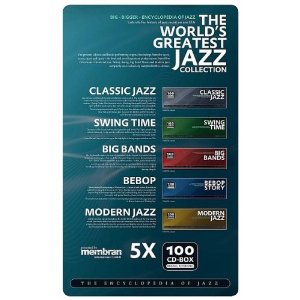
The entire set is available from amazon, under the title “The World’s Greatest Jazz Collection”



